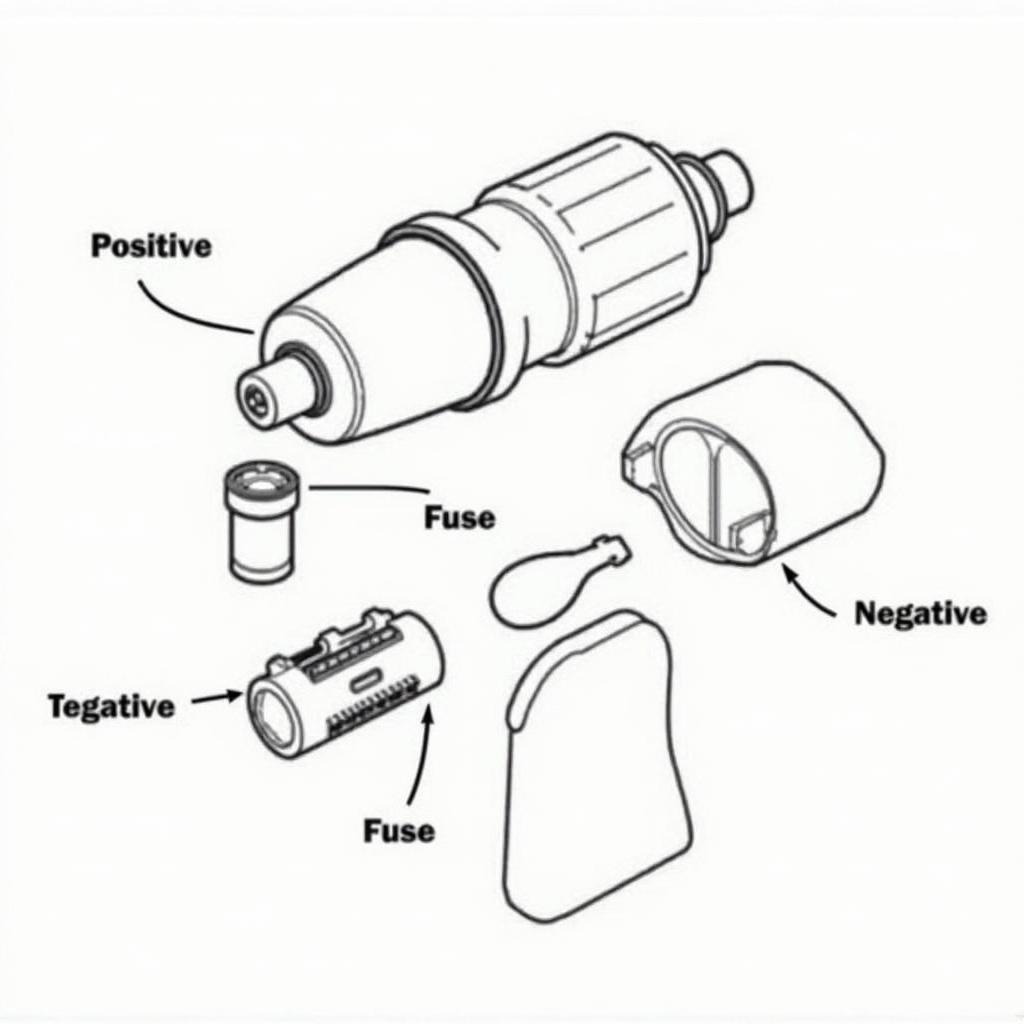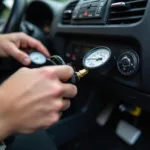The car cigarette lighter plug, often overlooked, plays a crucial role in modern vehicles. From powering essential devices like GPS navigators and phone chargers to providing a convenient source of power for portable vacuums and air compressors, this seemingly simple outlet offers remarkable versatility. But what happens when your trusty cigarette lighter plug decides to call it quits? This comprehensive guide delves deep into the world of car cigarette lighter plug repair, equipping you with the knowledge to troubleshoot, fix, or replace this essential component.
Understanding Your Car’s Cigarette Lighter Plug
Before we dive into repairs, it’s crucial to understand the mechanics of this unassuming power source. Contrary to its name, the car cigarette lighter plug rarely accommodates cigarettes anymore. Instead, it has evolved into a standardized power outlet known as an “accessory outlet” or a “12V power outlet.”
The plug typically consists of a metal housing with a positive terminal in the center and a negative terminal on the side. When you insert a device, the positive and negative terminals connect, completing a circuit and providing power.
Common Car Cigarette Lighter Plug Issues
Several telltale signs indicate a malfunctioning car cigarette lighter plug. Recognizing these symptoms early can save you from potential headaches down the road.
- No Power: This is the most obvious sign – your devices simply won’t charge or turn on when plugged in.
- Intermittent Power: Experiencing flickering power or devices sporadically disconnecting suggests a loose connection within the plug or wiring.
- Overheating: A hot cigarette lighter plug, especially when nothing is plugged in, indicates a serious electrical problem and requires immediate attention.
- Physical Damage: A broken or damaged housing can expose electrical components, posing a safety hazard.
Troubleshooting Your Car Cigarette Lighter Plug
Often, the fix for a faulty car cigarette lighter plug is simpler than you might expect. Before rushing to a mechanic, consider these troubleshooting steps:
-
Check the Fuse: A blown fuse is a common culprit behind a non-functional cigarette lighter plug. Consult your vehicle’s owner’s manual to locate the correct fuse panel and fuse. Replace the blown fuse with a new one of the same amperage.
-
Inspect the Plug for Debris: Over time, dust, dirt, or even small objects can accumulate inside the plug, obstructing the connection. Use a can of compressed air or a cotton swab to gently clean the plug’s interior.
-
Examine the Wiring: A loose or damaged wire can disrupt the power flow. Carefully inspect the wires connected to the back of the cigarette lighter plug for any visible signs of wear and tear.
- Test with a Different Device: To rule out the possibility of a faulty device, try plugging in a different device that you know works correctly.
If these troubleshooting steps prove futile, it’s time to consider seeking professional assistance from a qualified car electrician.
Car Cigarette Lighter Plug Replacement
In cases where the plug itself is damaged or the issue persists despite troubleshooting, a replacement might be necessary. Fortunately, replacing a car cigarette lighter plug is a relatively straightforward procedure.
Tools You’ll Need:
- Screwdriver (Phillips or flathead, depending on your vehicle model)
- Panel removal tool (optional)
- New cigarette lighter plug (compatible with your vehicle’s make and model)
Replacement Steps:
-
Disconnect the Battery: For safety, always disconnect the negative terminal of your car battery before working on any electrical components.
-
Locate and Access the Plug: Refer to your owner’s manual to locate the cigarette lighter plug in your vehicle. You might need to remove a trim panel or console cover to access the plug.
-
Disconnect the Wiring: Carefully disconnect the wiring harness connected to the back of the cigarette lighter plug.
-
Remove and Install the Plug: Gently pry out the old cigarette lighter plug from its housing. Insert the new plug into the housing, ensuring it sits flush and securely.
-
Reconnect the Wiring and Battery: Connect the wiring harness to the new plug, making sure the connections are secure. Reconnect the negative terminal of your battery.
-
Test the New Plug: Turn on your vehicle’s ignition and test the new cigarette lighter plug with a device to confirm it’s functioning correctly.
Beyond Repairs: Car Cigarette Lighter Plug Adapters and Alternatives
While a functional cigarette lighter plug is undeniably convenient, various adapters and alternatives exist to expand its functionality or provide power solutions when the plug itself malfunctions.
- USB Car Chargers: These handy adapters plug into the cigarette lighter socket and offer multiple USB ports, allowing you to charge several devices simultaneously.
- 12V Power Inverters: Transform your cigarette lighter socket into a standard household outlet with a power inverter. This allows you to power laptops, small appliances, and other devices that require AC power.
- Hardwiring Devices: Consider hardwiring frequently used devices like dashcams or GPS navigators directly to your vehicle’s electrical system for a more permanent and streamlined solution.
“Remember, safety should always be your top priority when dealing with car electricals. If you’re unsure about any step of the repair or replacement process, don’t hesitate to seek assistance from a qualified automotive electrician.” – John Smith, Senior Automotive Electrician at CarRepairOnline.
Conclusion
A malfunctioning car cigarette lighter plug doesn’t have to be a major inconvenience. By understanding the basics of how this simple yet essential component works, you can often troubleshoot and even fix minor issues yourself. However, always prioritize safety and seek professional help if you encounter complex electrical problems or are unsure about any aspect of the repair process. By following the tips and guidelines outlined in this article, you can keep your car’s power flowing and your devices charged for all your journeys.
Frequently Asked Questions
Q1: How much does it cost to fix a car cigarette lighter plug?
The cost can vary depending on the issue and whether you choose to repair or replace the plug. A simple fuse replacement might cost a few dollars, while a professional repair or replacement could range from $50 to $150.
Q2: Can I use any cigarette lighter plug for my car?
No, it’s crucial to use a cigarette lighter plug compatible with your vehicle’s make and model.
Q3: Why is my car cigarette lighter plug not working even after replacing the fuse?
If the plug still doesn’t work after replacing the fuse, the issue might lie with the wiring, the plug itself, or a deeper electrical problem.
Q4: Can I drive my car with a broken cigarette lighter plug?
While a broken cigarette lighter plug might not directly impact your car’s drivability, it poses a potential safety hazard due to exposed electrical components.
Q5: How do I know if my car cigarette lighter plug needs replacing?
Signs like physical damage, persistent power issues despite troubleshooting, and overheating indicate the need for a replacement.
Need help with your car’s electrical system? We’re here to help!
Check out our guides on car tail light repair and car LED light repair for more information on common car lighting issues and solutions. You can also learn about repairing car headlights in Toledo and access a directory of trusted car lighting repair shops with telephone numbers.
For DIY enthusiasts, we offer comprehensive self-maintenance car repair flashlights sheets to guide you through various repair tasks.
Still need assistance? Contact our team of experts via WhatsApp at +1(641)206-8880 or email us at [email protected]. We’re available 24/7 to answer your questions and provide top-notch support.



